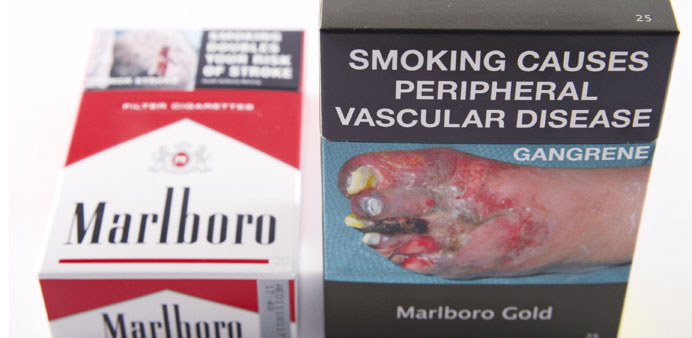Companies argue that putting smokes in dull green packets with graphic pictures of diseased organs is a failed experiment that has robbed the treasury of revenue and been a boon to the black market.
DPA/London
Britain is set to follow Ireland and copy Australia’s world-first legislation that cut smoking rates by putting cigarettes in plain packets.
Stop right there, tobacco companies protest.
They argue that putting smokes in dull green packets with graphic pictures of diseased organs is a failed experiment that has robbed the treasury of revenue and been a boon to the black market.
Imperial Tobacco, which has 40% of sales in Britain, said that since Australia’s 2012 initiative “there remains no credible evidence that plain packaging is having any impact on tobacco consumption rates.”
The tobacco companies fought that legislation right the way up to the nation’s highest court, eventually failing in their case that tobacco is as legal as chocolate and harming branding an illegal restraint on trade.
Proponents of the measure, of course, argue that tobacco companies would not be so dead against plain packaging if it did not reduce smoking rates.
They say branded cigarettes are “badge” products that glamourise smoking and are ever-present “silent salesmen” for a harmful product.
They dismiss as implausible the industry’s argument that the fiesta of colour that is brand imagery only serves to win over those who are already smokers.
Sir Cyril Chantler, who wrote an independent report for the government and submitted it March, said there was strong evidence that tobacco advertising and promotion increases the likelihood of children taking up smoking.
Chantler said: “The tobacco industry argues that all of its marketing activity, including packaging, aims solely to persuade existing adult smokers to switch brand and never targets children or new smokers. However, in my opinion, whatever their intent, it is not plausible that the effect of branded packaging is only to encourage brand switching amongst adult smokers, and never to encourage non-smokers from taking up smoking.”
The legislation is to be brought before parliament by May and could be on the statute books by next year. There is nobody in the public health sector who is not overjoyed.
“Two-thirds of smokers start before the age of 18, beginning an addiction which will kill half of them if they become long-term smokers,” said Harpal Kumar, head of Cancer Research UK. “By stripping cigarette packs of their marketing features, we can reduce the number of young people lured into an addiction, the products of which are death and disease.”
But there are lots of people, non-smokers among them, that deplore an initiative begun in Australia and taken up in Ireland.
The Irish parliament approved legislation on Tuesday requiring tobacco products to be sold in plain, dark packaging with large-print warnings and graphic images of the health effects of tobacco use.
New Zealand and France are among other countries considering similar legislation, which tobacco firms have vowed to fight in the courts.
Paul Baxter is chief executive of Britain’s National Federation of Retail Newsagents (NFRN), whose members look to cigarettes as a source of income.
Already, cigarette sellers feel they have their backs against the wall. From April, packs of cigarettes will have to be hidden from view in all shops.
Baxter, like the tobacco companies, is warning that plain packaging will drive the trade in tobacco underground.



